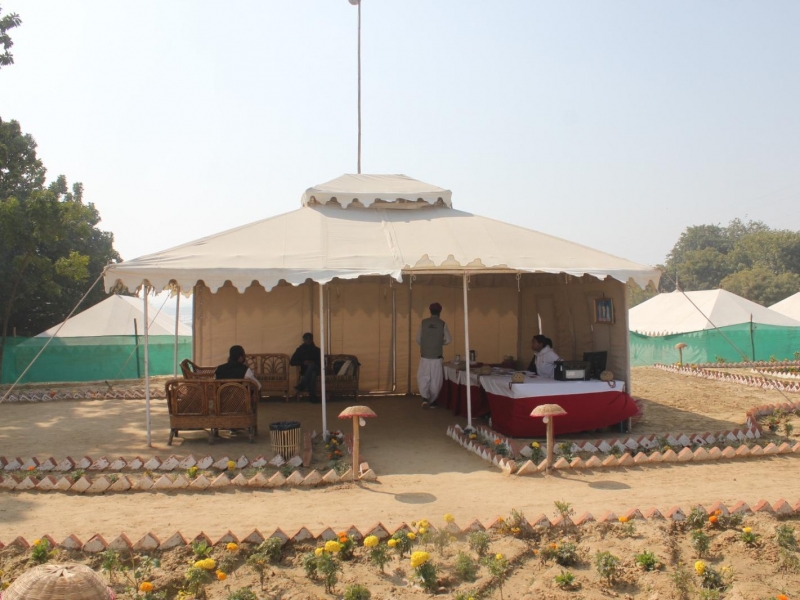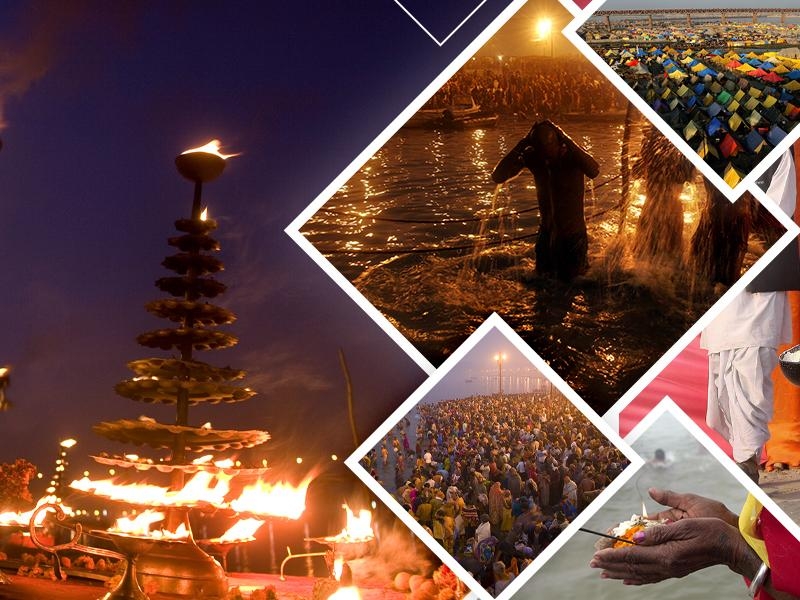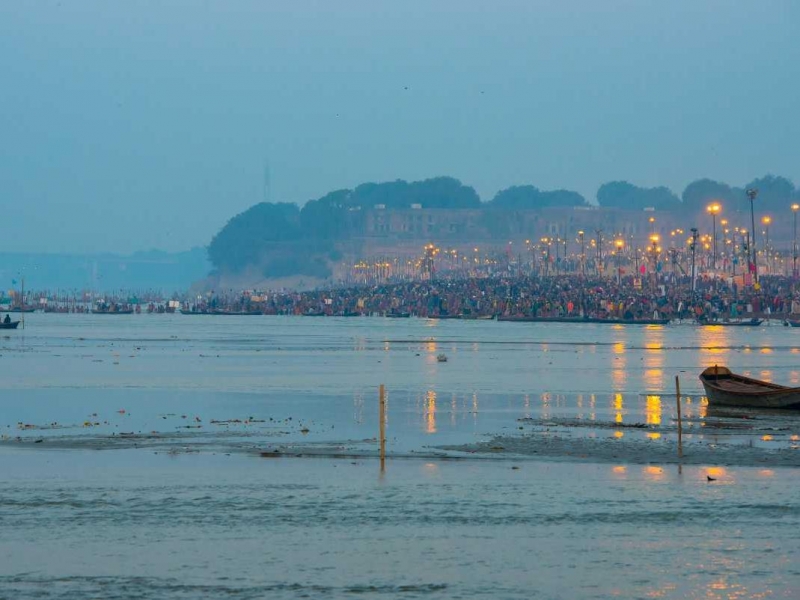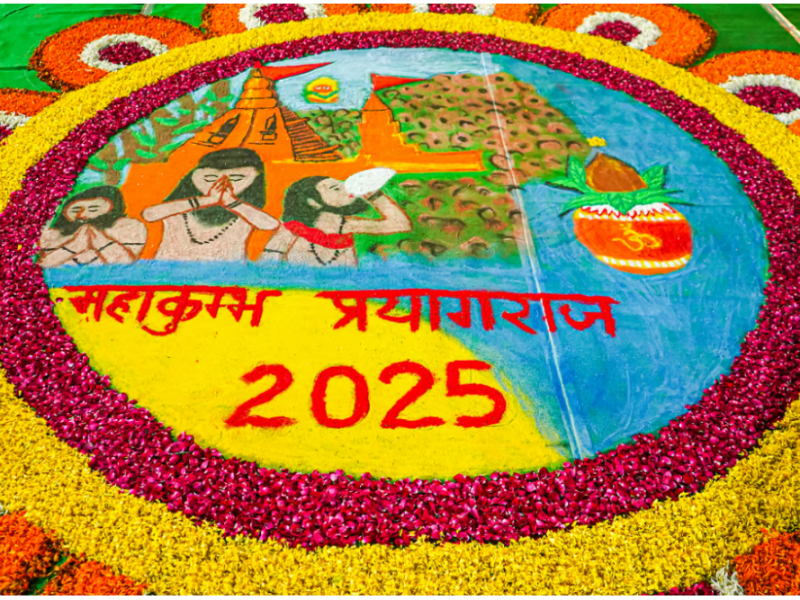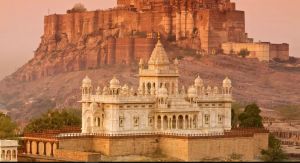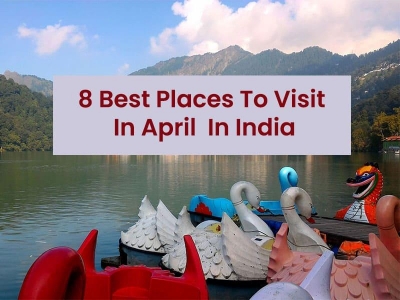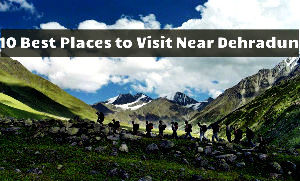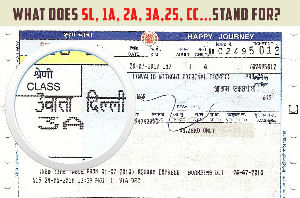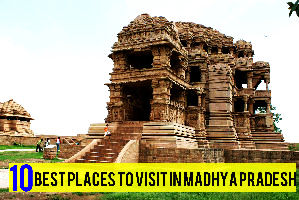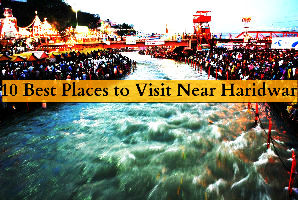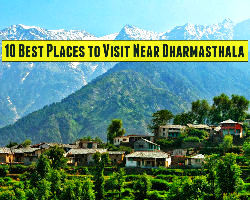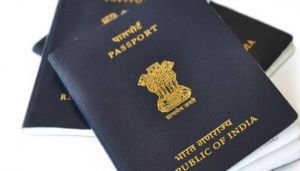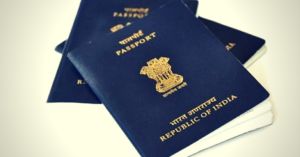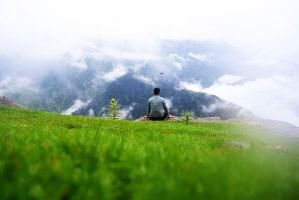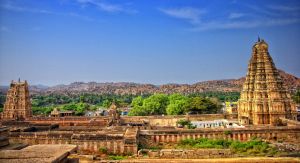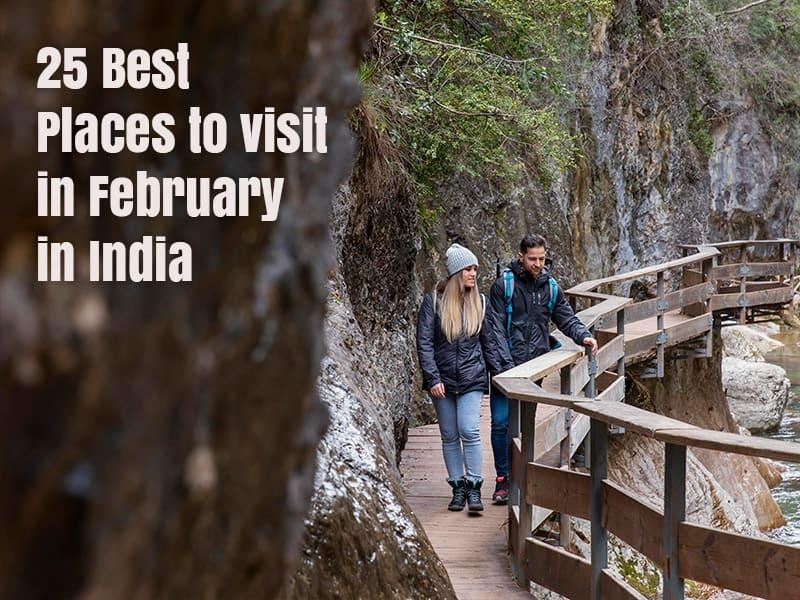
February is the month of romance and we can thank to st. Valentine’s as everywhere it’s love in the air. Whereas February also calls for the end of tourist season, and all the tourist rush is already back to their homes. So those who have fear of summers and don’t like to go out in summers, then they need to pull up their socks, as summers are just a month away. Therefore, February is considered to be as the most pleasant and best month to travel with your loved ones. As one can enjoy the steer clear views of all the places without tourist rush. Whereas there are myriad of places to explore in February, but we always end up being confused, which city to go and where it's going to be cold or festivities to attend in the month of February. And luckily, India offers a lot many places to visit in February, where you can fly with your better half to spend some close and romantic moments together. Not just the couples, even if you are single and yet planning to travel in February in search of natural beauty try choosing your pick from this well-researched list of best places to visit in February in India. Where you can enjoy the breathtaking views of Gulmarg, fly in the mountains, doing paragliding in Bir-Billing valleys, Tipple the night away in Sula vineyards, Camp in Rann of Kutch in Gujarat. Thus we have sorted out everything for you, just pick your favorite places to explore in February and make the most of the shortest month of the year.
1. Gulmarg
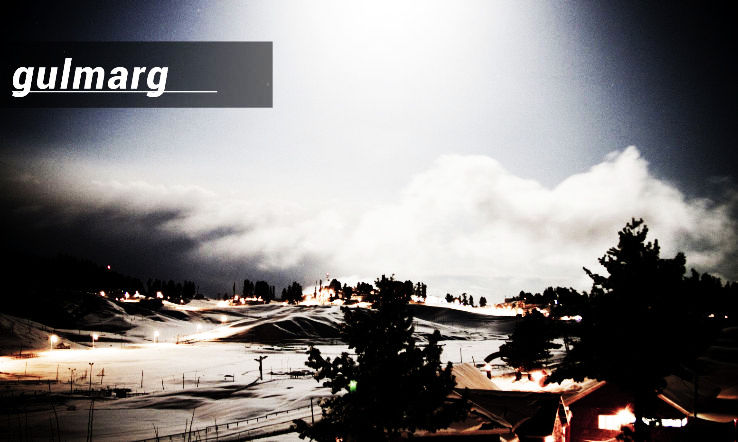
Location: Gulmarg is located in the Baramulla district of the Indian-administered union territory of Jammu and Kashmir.
Altitude: It is situated at an altitude of around 8,694 feet 2,650 meters above sea level.
Scenic Beauty: Gulmarg is renowned for its picturesque beauty, with lush green meadows, dense forests, and snow-capped mountains.
Skiing Destination: It is one of the premier skiing destinations in India, attracting skiers and snowboarders from around the world during the winter months.
Gulmarg Gondola: The Gulmarg Gondola is one of the highest cable cars in the world and offers breathtaking views of the surrounding Himalayan peaks.
Adventure Sports: Apart from skiing, Gulmarg offers opportunities for trekking, snowboarding, mountain biking, and golfing during the summer months.
Alpather Lake: This serene lake is located around 13 kilometers from Gulmarg and is known for its scenic beauty, especially when it's frozen during winter.
Gulmarg Biosphere Reserve: The region around Gulmarg is home to diverse flora and fauna, and efforts are made to conserve its natural habitat through the Gulmarg Biosphere Reserve.
Gulmarg Golf Course: Established in 1911, the Gulmarg Golf Course is one of the highest golf courses in the world and offers a unique golfing experience amidst breathtaking scenery.
Tourism: Despite occasional political tensions in the region, Gulmarg continues to attract tourists throughout the year, offering them a glimpse of its natural beauty and adventure activities.
Best time to visit: Gulmarg is during the summer months, from May to September, when the weather is pleasant and ideal for outdoor activities such as trekking, golfing, and enjoying the lush greenery. Winter, from December to February, is also popular for skiing and snowboarding enthusiasts, as Gulmarg transforms into a winter wonderland with heavy snowfall and excellent skiing conditions.
How to reach: To reach Gulmarg, you can fly into Srinagar Airport, which is the nearest airport, and then take a taxi or a bus to Gulmarg, which is about a 2-hour drive away. Alternatively, you can also take a train to Jammu Tawi Railway Station and then continue by road to Gulmarg, which is approximately a 7-hour drive.
2. Jaisalmer
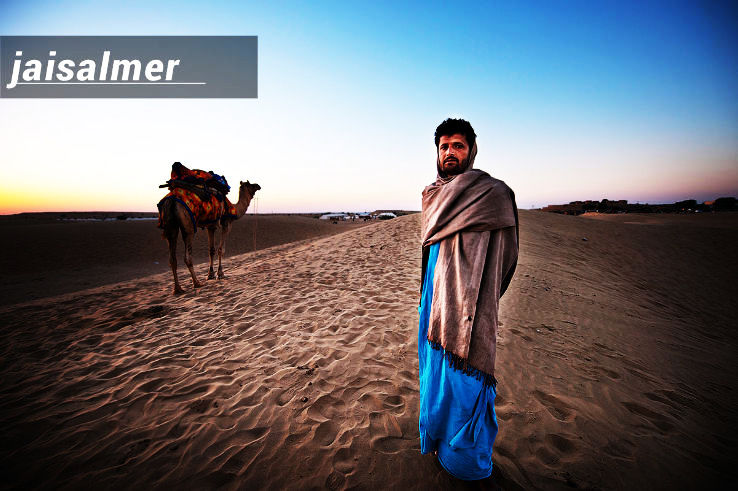
The place to watch the desert festival in February,Jaisalmer is a historic city located in the desert state of Rajasthan, India.
The city is famous: for its stunning sandstone architecture, earning it the nickname "Golden City."The centerpiece of Jaisalmer is its imposing Jaisalmer Fort, a UNESCO World Heritage Site known for its intricate carvings and majestic gates.
Jaisalmer Fort: is one of the few living forts in the world, with a significant population still residing within its walls.The city is surrounded by the vast Thar Desert, offering opportunities for camel safaris, desert camping, and dune bashing.
Jaisalmer: is renowned for its vibrant culture, including folk music, dance, and traditional Rajasthani cuisine.The city hosts several festivals throughout the year, with the Jaisalmer Desert Festival being the most popular, showcasing local music, dance, and camel races.
Patwon Ki Haveli: Nathmal Ki Haveli, and Salim Singh Ki Haveli are among the ornate merchant mansions that reflect the city's wealthy past.
Gadisar Lake: a man-made reservoir surrounded by temples and shrines, provides a tranquil escape from the desert heat.Jaisalmer is also a popular destination for heritage tourism, attracting visitors with its rich history, architectural marvels, and enchanting desert landscapes.
Popularly known: as the 'Golden City of India', Jaisalmer presents arrays of royal edifices that speak louder about the bygone era. Located on the ridge of yellow sandstone, the city is labeled as a UNESCO World Heritage Site and looks stunning for lying on the heart of Thar Desert. Artistically enriched havelis, royal residences, colorful markets, and twisting lanes offer the tourists a happening break. Desert Festival is the most significant festival of Jaisalmer which is going to be held in February, which shows the traditional culture of Rajasthan. The fusion of dance, attire, and music is shown extravagantly, where many events and dance shows take place. Therefore, February is the best month to plan your holidays in Jaisalmer and be the spectator of an array of events.
Best time to visit: Jaisalmer is from October to March, during the winter season, when the weather is pleasant and suitable for exploring the city's attractions and enjoying desert activities. Avoid visiting during the summer months April to June as temperatures soar and the desert heat becomes unbearable.
How to reach: To reach Jaisalmer, you can fly into Jodhpur Airport, which is the nearest airport, and then take a taxi or a bus for about a 5-hour drive to Jaisalmer. Alternatively, you can also take a train to Jaisalmer Railway Station, which is well-connected to major cities like Delhi, Jaipur, and Mumbai.
3. Goa
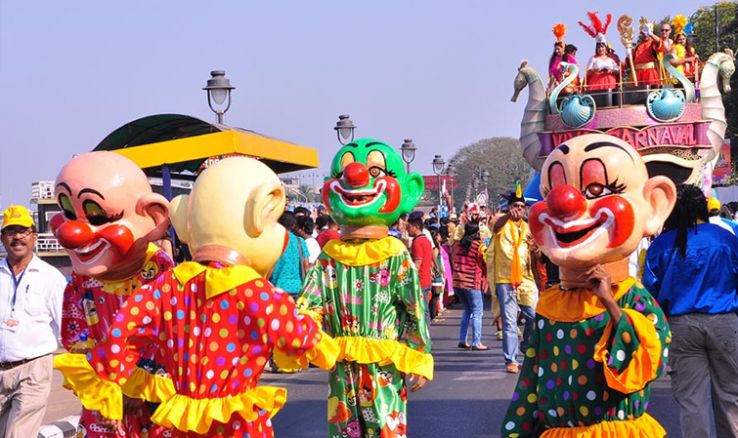
Beaches: Goa is famous for its pristine beaches, offering opportunities for sunbathing, water sports, and relaxation.
Architecture: The state boasts a rich architectural heritage, with Portuguese colonial buildings, ancient temples, and churches.
Nightlife: Goa is renowned for its vibrant nightlife, with beach shacks, clubs, and bars hosting parties and live music events.
Cuisine: Visitors can savor a variety of delicious Goan cuisine, known for its use of seafood, coconut, and spices.
Water Sports: Adventure enthusiasts can indulge in a range of water sports such as parasailing, jet-skiing, and windsurfing.
Flea Markets: Goa's flea markets are popular shopping destinations, offering a wide range of handicrafts, clothing, and souvenirs.
Wildlife: The state is home to diverse wildlife sanctuaries and national parks, where visitors can spot unique flora and fauna.
Spice Plantations: Guided tours of spice plantations provide insight into Goa's spice cultivation and offer opportunities to sample fresh spices.
Cultural Events: Goa hosts various cultural festivals and events throughout the year, including music festivals, food festivals, and religious celebrations.
Relaxation: With its laid-back vibe and scenic beauty, Goa is the perfect destination for relaxation, yoga retreats, and wellness activities.
best time to visit: Goa is from November to February, during the winter season, when the weather is pleasant with clear skies and cool temperatures, ideal for beach activities and sightseeing. Avoid visiting during the monsoon season June to September as heavy rainfall can disrupt travel plans and water-based activities.
How to reach: To reach Goa, you can fly into Goa International Airport Dabolim Airport, which is well-connected to major cities in India and abroad. Alternatively, you can also travel by train to Goa's major railway stations like Madgaon Margao or Thivim, or by bus from nearby cities and states.
4. Coorg
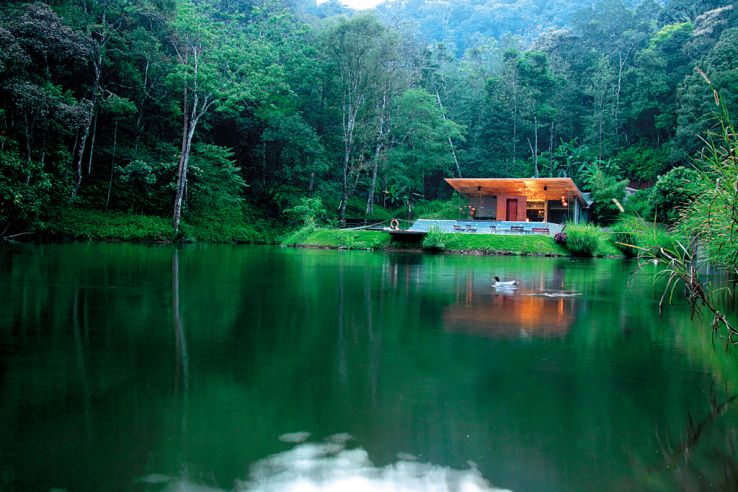
Location: Coorg, officially known as Kodagu, is a picturesque hill station located in the southwestern part of Karnataka, India.
Landscape: The region is renowned for its lush greenery, mist-covered hills, and coffee plantations, making it a popular destination for nature lovers.
Coffee Plantations: Coorg is one of the largest coffee-producing regions in India, and visitors can explore its scenic coffee estates and learn about coffee cultivation.
Talakaveri: It is the origin of the river Kaveri, and there is a temple dedicated to Goddess Kaveriamma at this spot.
Abbey Falls: One of the most popular tourist attractions in Coorg, Abbey Falls is a magnificent waterfall cascading from a height of around 70 feet amidst dense foliage.
Madikeri Fort: This historical fort, located in the heart of Madikeri town, offers panoramic views of the surrounding hills and houses a museum and a temple.
Namdroling Monastery: Also known as the Golden Temple, Namdroling Monastery is one of the largest Tibetan Buddhist monasteries in India, adorned with colorful murals and intricate architecture.
Dubare Elephant Camp: Situated on the banks of the Kaveri River, this camp offers visitors the opportunity to interact with elephants, participate in elephant bathing, and learn about their care and conservation.
Raja's Seat: A popular viewpoint in Madikeri, Raja's Seat offers stunning panoramic views of the surrounding hills and valleys, especially during sunrise and sunset.
Talacauvery Wildlife Sanctuary: This sanctuary is home to a variety of flora and fauna, including elephants, deer, and rare bird species, making it an ideal destination for wildlife enthusiasts.
Best time to visit: Coorg is from October to March, during the winter and early spring seasons, when the weather is cool, pleasant, and ideal for exploring the lush greenery, waterfalls, and coffee plantations. Avoid visiting during the monsoon season June to September as heavy rainfall can lead to landslides and hinder outdoor activities.
How to reach: To reach Coorg, you can fly into either Mangalore International Airport or Kannur International Airport, both of which are the nearest airports to Coorg. From there, you can hire a taxi or take a bus to reach Coorg, which is approximately a 3 to 4-hour drive away.
5. Andaman and Nicobar Islands
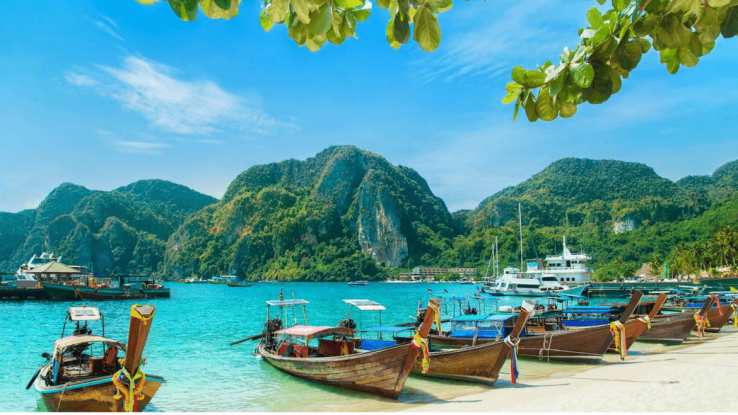
Location: The Andaman and Nicobar Islands are a group of islands located in the Bay of Bengal, closer to Thailand and Myanmar than to mainland India.
Biodiversity: The islands are known for their rich biodiversity, with lush rainforests, pristine beaches, and diverse marine life.
Cellular Jail: Located in Port Blair, Cellular Jail is a historic colonial prison where Indian freedom fighters were imprisoned during the British rule.
Radhanagar Beach: Often rated as one of the best beaches in Asia, Radhanagar Beach on Havelock Island boasts powdery white sands and crystal-clear waters.
Scuba Diving and Snorkeling: The Andaman and Nicobar Islands offer excellent opportunities for scuba diving and snorkeling, with vibrant coral reefs and abundant marine life.
Ross Island: Once the administrative headquarters of the British in the Andaman Islands, Ross Island now lies in ruins, with remnants of colonial buildings and a serene ambiance.
Baratang Island: Known for its limestone caves, mangrove forests, and mud volcanoes, Baratang Island is a popular day trip destination from Port Blair.
Neil Island: Famous for its laid-back vibe and pristine beaches, Neil Island is ideal for relaxation and water sports such as snorkeling and glass-bottom boat rides.
Indigenous Tribes: The Andaman and Nicobar Islands are home to several indigenous tribes, including the Jarawa, Sentinelese, and Onge, who have lived in isolation for thousands of years.
Mahatma Gandhi Marine National Park: Located near Wandoor, this national park is known for its diverse marine ecosystem, including coral reefs, mangroves, and marine wildlife.
Best time to visit: the Andaman and Nicobar Islands is from November to April, during the winter and early summer months, when the weather is pleasant with calm seas, clear skies, and ideal conditions for water activities like scuba diving, snorkeling, and beach exploration.
How to reach: To reach the Andaman and Nicobar Islands, you can fly into Veer Savarkar International Airport in Port Blair, which is the main airport serving the islands. Flights to Port Blair are available from major cities in India such as Delhi, Mumbai, Chennai, and Kolkata. Additionally, there are also ships available from Chennai, Kolkata, and Vishakhapatnam, but the journey takes significantly longer around 3-4 days compared to flying.
6. Sikkim
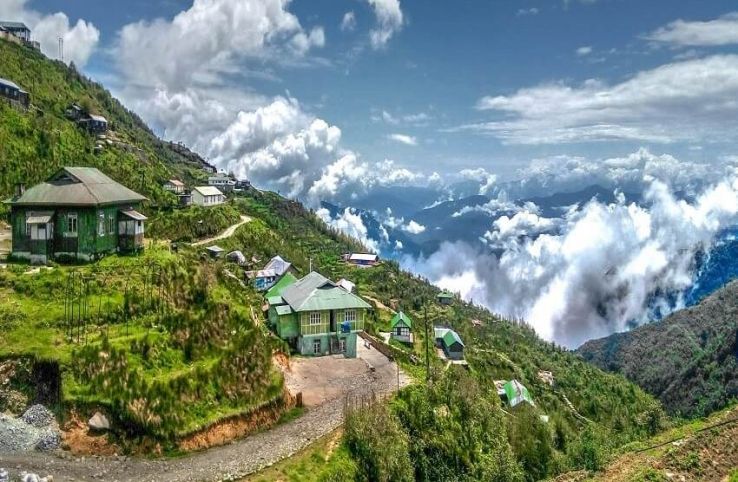
Location: Sikkim is a small state nestled in the northeastern part of India, bordered by Nepal, Bhutan, and Tibet China.
Capital: The capital of Sikkim is Gangtok, which is known for its picturesque landscapes, Buddhist monasteries, and vibrant culture.
Himalayan Range: Sikkim is situated in the eastern Himalayas, offering stunning views of snow-capped peaks, including the world's third highest mountain, Kangchenjunga.
Buddhism: Sikkim is predominantly a Buddhist state, and visitors can explore numerous monasteries, stupas, and prayer flags spread across the region.
Yumthang Valley: Often referred to as the "Valley of Flowers," Yumthang Valley is known for its alpine meadows, hot springs, and blooming rhododendrons during spring.
Gurudongmar Lake: Located at an altitude of over 17,000 feet, Gurudongmar Lake is one of the highest lakes in the world and holds religious significance for both Buddhists and Hindus.
Nathu La Pass: This high-altitude mountain pass connects Sikkim with Tibet and offers breathtaking views of the surrounding peaks and valleys.
Wildlife: Sikkim is home to a diverse range of flora and fauna, including the elusive snow leopard, red panda, Himalayan black bear, and various species of birds.
Trekking: The state offers numerous trekking routes, including the popular Goecha La Trek, which takes trekkers through pristine forests, glacial valleys, and high mountain passes.
Cultural Festivals: Sikkim celebrates several cultural festivals throughout the year, such as Losar Tibetan New Year, Saga Dawa, and Pang Lhabsol, showcasing its rich cultural heritage and traditions.
Best time to visit: Sikkim is during the months of March to June and September to November when the weather is pleasant with clear skies, making it ideal for sightseeing, trekking, and exploring the natural beauty of the region. Avoid visiting during the monsoon season July to August due to heavy rainfall, which may lead to landslides and disrupt travel plans.
How to reach: To reach Sikkim, you can fly into Bagdogra Airport, which is the nearest airport located in the neighboring state of West Bengal. From there, you can take a taxi or bus to Gangtok, the capital city of Sikkim, which is approximately a 4 to 5-hour drive away. Alternatively, you can also travel by train to New Jalpaiguri Railway Station and then proceed to Gangtok by road.
7. Prayagraj
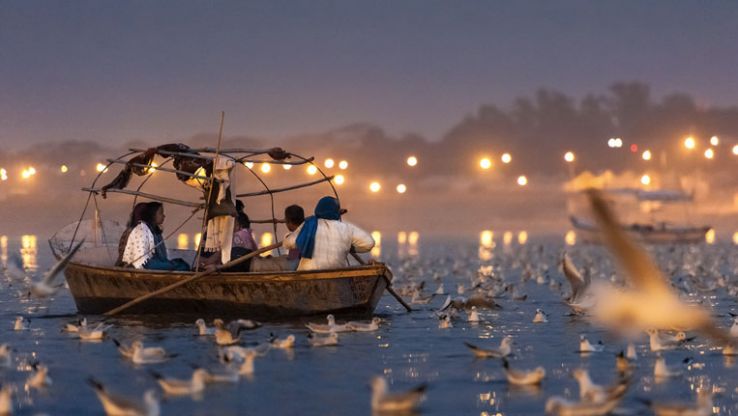
Triveni Sangam: The confluence of three holy rivers - Ganga, Yamuna, and Saraswati, is a sacred site for Hindus.
Kumbh Mela: Prayagraj hosts the world's largest religious gathering, the Kumbh Mela, where millions of pilgrims come to bathe in the holy waters.
Allahabad Fort: Built by Emperor Akbar in the 16th century, this fort houses several historic monuments and the famous Akshaya Vat tree.
Anand Bhavan: The ancestral home of the Nehru-Gandhi family, now a museum showcasing the life and times of Jawaharlal Nehru and the freedom struggle.
Allahabad High Court: One of the oldest high courts in India, known for its architectural beauty and legal significance.
Alfred Park: A sprawling park named after Prince Alfred, where the famous uprising against British rule, the Indian Rebellion of 1857, began.
Chandra Shekhar Azad Park: Formerly known as Company Bagh, this park is dedicated to the freedom fighter Chandra Shekhar Azad and features his statue.
Allahabad Museum: A repository of historical artifacts, sculptures, and paintings, providing insights into the cultural heritage of the region.
Minto Park: Also known as Madan Mohan Malviya Park, it offers serene surroundings and a children's playground.
All Saints Cathedral: A beautiful Anglican cathedral known for its Gothic architecture and stained glass windows.
Best time to visit: Prayagraj is during the winter months, from October to March, when the weather is pleasant and comfortable for exploring the city's attractions and attending events such as the Kumbh Mela. Avoid visiting during the summer months April to June when temperatures can soar, making sightseeing and outdoor activities uncomfortable
How to reach: To reach Prayagraj, you can fly into Allahabad Airport Bamrauli Airport, which offers domestic flights from major cities in India. Alternatively, you can also travel by train to Allahabad Junction Railway Station, which is well-connected to major cities across the country.
8. Agra
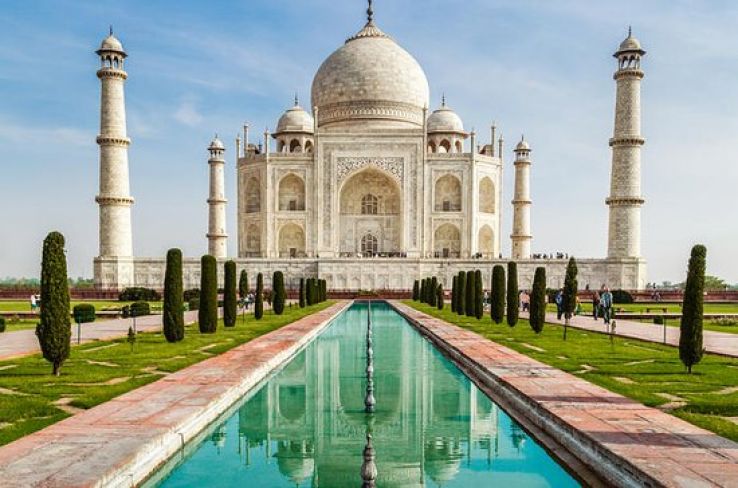
Taj Mahal: A UNESCO World Heritage Site and one of the Seven Wonders of the World, the Taj Mahal is an iconic symbol of love and a must-visit monument in Agra.
Agra Fort: Another UNESCO World Heritage Site, Agra Fort is a majestic fortress built by the Mughal emperors, offering stunning architecture and panoramic views of the Taj Mahal.
Fatehpur Sikri: Located near Agra, Fatehpur Sikri is a well-preserved Mughal city built by Emperor Akbar, known for its beautiful palaces, mosques, and Buland Darwaza.
Itmad-ud-Daulah's Tomb: Often referred to as the "Baby Taj," this exquisite tomb is a precursor to the Taj Mahal and showcases intricate marble inlay work.
Mehtab Bagh: Situated across the Yamuna River from the Taj Mahal, Mehtab Bagh is a serene garden offering stunning views of the monument at sunset.
Jama Masjid: A grand mosque built by Shah Jahan, Jama Masjid is known for its impressive architecture, intricate carvings, and large courtyard.
Sikandra: The tomb of Emperor Akbar, located in the outskirts of Agra, is a magnificent structure combining elements of Hindu, Islamic, and Persian architecture.
Mughal Heritage Walk: Explore the streets and markets of Agra on this guided walk, discovering the city's rich Mughal heritage and sampling local cuisine.
Taj Museum: Located within the Taj Mahal complex, the museum exhibits artifacts and documents related to the construction and history of the monument.
Shilpgram: A craft village near the Taj Mahal, Shilpgram showcases traditional arts and crafts of India, including marble carving, embroidery, and pottery.
Best time to visit: Agra is during the winter months, from October to March, when the weather is pleasant and comfortable for exploring the city's attractions, especially the Taj Mahal and Agra Fort. Avoid visiting during the summer months April to June when temperatures can soar, making sightseeing uncomfortable.
How to reach: To reach Agra, you can fly into Indira Gandhi International Airport in Delhi, which is the nearest major airport, and then travel to Agra by train, bus, or taxi, approximately a 3-4 hour drive away. Alternatively, you can also take a train directly to Agra from major cities in India, as Agra is well-connected by rail.
9. Puri
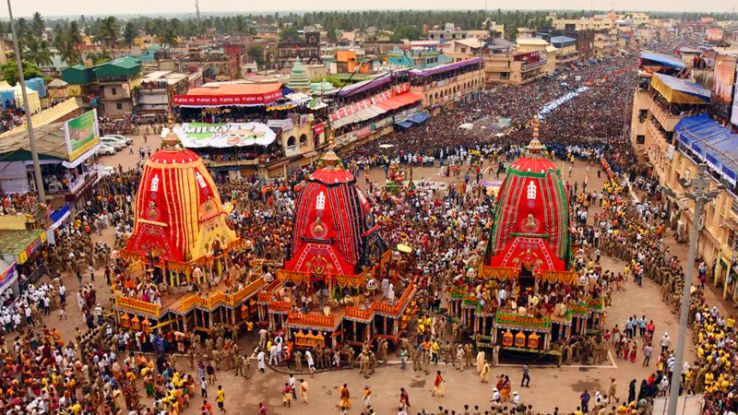
Location: Puri is a coastal city located in the state of Odisha, India, along the Bay of Bengal.
Jagannath Temple: One of the most famous Hindu temples in India, the Jagannath Temple is dedicated to Lord Jagannath and hosts the annual Rath Yatra festival.
Rath Yatra: The Rath Yatra festival, also known as the Chariot Festival, is a grand procession where the deities of Jagannath, Balabhadra, and Subhadra are taken out in chariots.
Puri Beach: A popular tourist destination, Puri Beach offers sandy shores, clear waters, and opportunities for swimming, sunbathing, and beach activities.
Konark Sun Temple: Located around 35 kilometers from Puri, the Konark Sun Temple is a UNESCO World Heritage Site known for its exquisite architecture and intricate carvings.
Chandrabhaga Beach: Another scenic beach near Puri, Chandrabhaga Beach is known for its golden sands, clear waters, and serene ambiance.
Gundicha Temple: This temple is dedicated to Goddess Gundicha, Lord Jagannath's aunt, and is an important pilgrimage site visited during the Rath Yatra festival.
Puri Sea Beach Festival: Held annually in November, the Puri Beach Festival celebrates Odisha's culture, arts, crafts, and cuisine, attracting tourists from around the world.
Chilika Lake: The largest brackish water lagoon in Asia, Chilika Lake is located near Puri and is a haven for birdwatching, boating, and exploring wildlife.
Odisha Maritime Museum: Located in Puri, this museum showcases the maritime history and heritage of Odisha, including exhibits on boats, navigation, and seafaring traditions.
Best time to visit: Puri is from October to March, during the winter and early spring months, when the weather is pleasant and comfortable for sightseeing, beach activities, and attending festivals like the Rath Yatra. Avoid visiting during the monsoon season June to September when heavy rainfall can disrupt travel plans and water-based activities.
How to reach: To reach Puri, you can fly into Biju Patnaik International Airport in Bhubaneswar, which is the nearest major airport located about 60 kilometers away. From there, you can take a taxi or bus to Puri, which is approximately a 1.5 to 2-hour drive. Additionally, Puri is well-connected by train, with regular trains running from major cities in India to Puri Railway Station.
10. Rann of Kutch
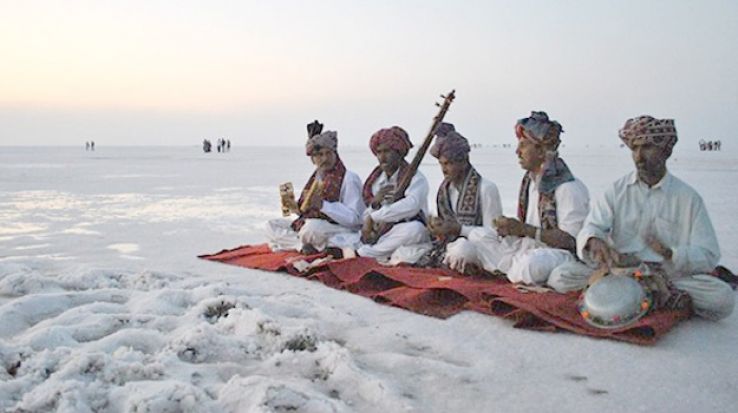
Great Rann of Kutch: The largest salt desert in the world, stretching over 7,500 square kilometers, known for its mesmerizing white salt flats and stunning vistas.
White Rann Festival: Held annually from November to February, the White Rann Festival showcases the cultural heritage of Kutch with folk music, dance, handicrafts, and camel safaris.
Kala Dungar Black Hill: The highest point in Kutch, offering panoramic views of the Rann of Kutch and the surrounding landscapes.
Kutch Desert Wildlife Sanctuary: Home to a diverse range of flora and fauna, including the endangered Indian wild ass, as well as desert foxes, wolves, and migratory birds.
Dholavira: An ancient Harappan archaeological site dating back over 4,000 years, known for its well-planned city layout, reservoirs, and artifacts.
Kutch Museum: Located in Bhuj, the museum houses a rich collection of artifacts, textiles, handicrafts, and historical exhibits showcasing the cultural heritage of Kutch.
Bhujodi: A village renowned for its traditional handloom weaving, where visitors can observe artisans at work and purchase exquisite textiles and handicrafts.
Mandvi Beach: A serene beach with golden sands, clear waters, and opportunities for swimming, sunbathing, and camel rides along the shore.
Aina Mahal: A historic palace in Bhuj known for its exquisite architecture, mirror work, and European-style interiors, now converted into a museum.
Rann Utsav: A cultural extravaganza held during the White Rann Festival, offering visitors the chance to experience the vibrant culture, cuisine, and hospitality of Kutch.
Best time to visit: the Rann of Kutch is during the winter months, from November to February, when the weather is pleasant and cool, making it ideal for exploring the salt desert and attending the White Rann Festival. Avoid visiting during the summer months March to June when temperatures can soar, making outdoor activities uncomfortable.
How to reach: To reach the Rann of Kutch, you can fly into Bhuj Airport, which is the nearest airport, and then travel by road to the various destinations within the Rann of Kutch. Alternatively, you can also take a train to Bhuj Railway Station and then proceed by road to the Rann of Kutch.
11. Bengaluru
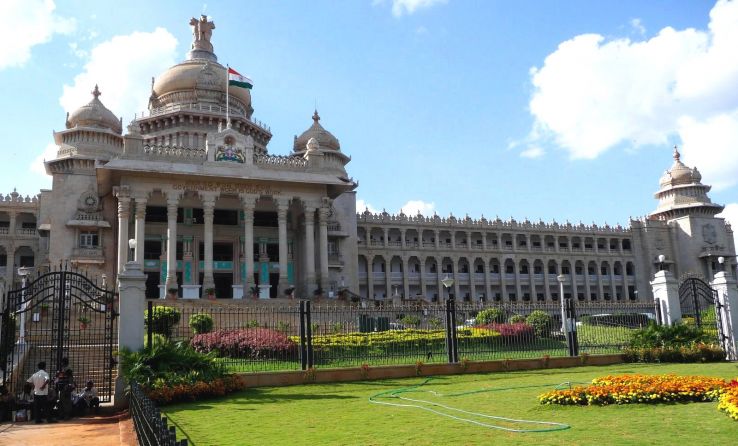
Lalbagh Botanical Garden: One of the most famous botanical gardens in India, Lalbagh is known for its vast collection of tropical plants, flower shows, and the iconic Glass House.
Cubbon Park: A sprawling green oasis in the heart of the city, Cubbon Park offers tranquil walking trails, landscaped gardens, and iconic landmarks like the Vidhana Soudha.
Bangalore Palace: Modeled after the Windsor Castle, Bangalore Palace is a magnificent royal residence showcasing Tudor-style architecture, antique furniture, and sprawling grounds.
Tipu Sultan's Summer Palace: A historical landmark built in the Indo-Islamic style, the palace features ornate arches, floral motifs, and a museum displaying artifacts related to Tipu Sultan.
Vidhana Soudha: The seat of the Karnataka State Legislature, Vidhana Soudha is a grand Neo-Dravidian-style building known for its majestic architecture and illuminated facade.
ISKCON Temple: Dedicated to Lord Krishna, the ISKCON Temple in Bengaluru is a spiritual and architectural marvel, featuring intricate carvings, a serene atmosphere, and cultural performances.
Bangalore Fort: A historic fort built by Kempe Gowda in the 16th century, now in ruins, with remnants like the Delhi Gate and the old fort walls.
Bannerghatta Biological Park: Home to a variety of wildlife, including lions, tigers, and elephants, the Bannerghatta Biological Park offers safaris, nature walks, and a butterfly park.
Innovative Film City: A popular entertainment complex offering a range of attractions such as a wax museum, mirror maze, 4D theater, and live shows.
UB City: A luxurious shopping and dining destination, UB City is known for its upscale boutiques, fine dining restaurants, and cultural events.
Best time to visit: Bengaluru is during the winter months, from October to February, when the weather is pleasant with cool temperatures, making it ideal for exploring the city's attractions and outdoor activities. Avoid visiting during the monsoon season June to September when heavy rainfall can disrupt travel plans and outdoor activities.
How to reach: To reach Bengaluru, you can fly into Kempegowda International Airport, which is the major airport serving the city, with domestic and international flights. Additionally, Bengaluru is well-connected by train, with several railway stations like Bengaluru City Junction and Yesvantpur Junction, and by bus, with a network of state-run and private bus services connecting the city to various destinations across India.
12. Nashik
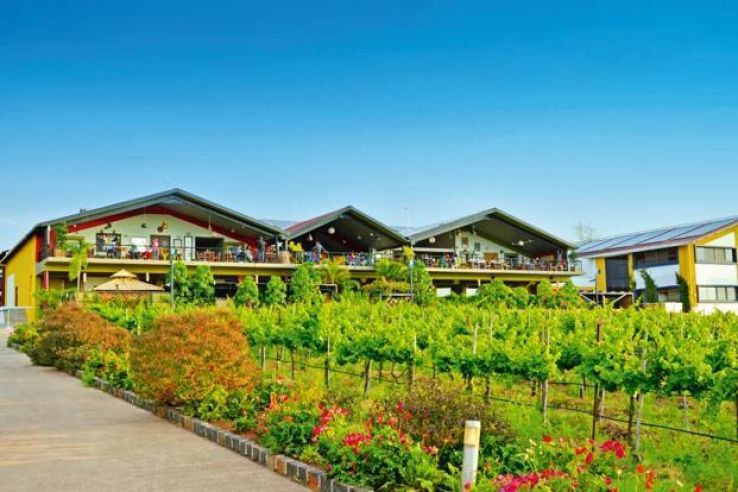
Sula Vineyards: One of India's most popular wineries, Sula Vineyards offers guided tours, wine tastings, and picturesque vineyard views.
Trimbakeshwar Temple: A sacred Hindu temple dedicated to Lord Shiva, Trimbakeshwar Temple is one of the twelve Jyotirlingas and attracts thousands of devotees.
Pandavleni Caves: Dating back to the 3rd century BCE, these ancient Buddhist caves feature intricate rock-cut architecture and beautiful carvings.
Sita Gufaa Cave: A mythological cave believed to be the hiding place of Sita during her exile, located near the Panchavati area in Nashik.
Kalaram Temple: A historic temple dedicated to Lord Rama, known for its striking black stone architecture and vibrant festivals.
Nashik Kumbh Mela: Held every 12 years, the Nashik Kumbh Mela is one of the largest religious gatherings in the world, attracting millions of pilgrims.
Anjaneri Hills: A popular trekking destination near Nashik, believed to be the birthplace of Lord Hanuman and offering scenic views of the surrounding landscape.
Dudhsagar Waterfall: A picturesque waterfall located near Nashik, surrounded by lush greenery and offering a refreshing retreat from the city.
Coin Museum: Managed by the Indian Institute of Research in Numismatic Studies, the Coin Museum showcases a vast collection of coins and artifacts related to Indian currency.
Saptashrungi Devi Temple: Located atop the Saptashrungi Hills, this temple is dedicated to Goddess Saptashrungi and offers panoramic views of the Nashik city.
Best time to visit: Nashik is from October to March, during the winter and early spring months, when the weather is pleasant and cool, ideal for exploring the city's attractions and vineyards. Avoid visiting during the summer months April to June when temperatures can soar, making outdoor activities uncomfortable.
How to reach: To reach Nashik, you can fly into Ozar Airport, which serves domestic flights, or Chhatrapati Shivaji Maharaj International Airport in Mumbai, located about 170 kilometers away. From there, you can travel to Nashik by bus, taxi, or train, with Nashik Road Railway Station being the main railway station in the city.
13. Thekkady
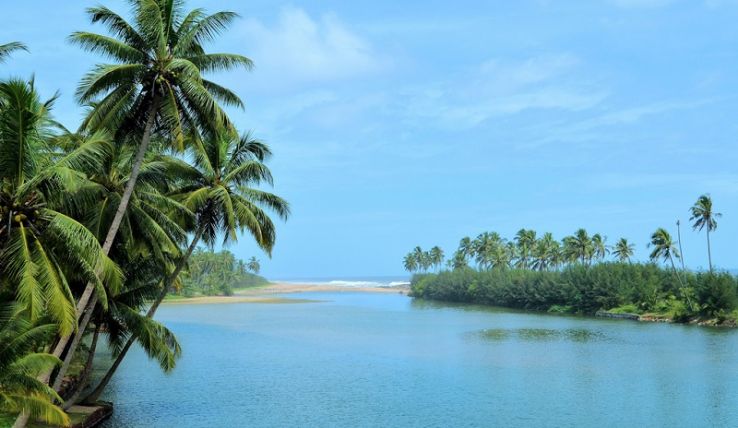
Periyar National Park: A renowned wildlife sanctuary, Periyar National Park is home to diverse flora and fauna, including elephants, tigers, and rare bird species.
Periyar Lake: A scenic artificial lake located within the national park, offering boat cruises where visitors can spot wildlife and enjoy breathtaking views of the surroundings.
Bamboo Rafting: Explore the serene waters of Periyar Lake on a bamboo rafting expedition, allowing for close encounters with wildlife and pristine natural beauty.
Spice Plantations: Thekkady is famous for its spice plantations, where visitors can take guided tours to learn about the cultivation and processing of spices like cardamom, pepper, and cinnamon.
Elephant Junction: Interact with elephants and enjoy activities like elephant rides, feeding, and bathing at Elephant Junction, a popular tourist attraction in Thekkady.
Kathakali Performances: Experience the vibrant culture of Kerala with traditional Kathakali dance performances, showcasing colorful costumes, elaborate makeup, and storytelling through dance and music.
Mullaperiyar Dam: Visit the Mullaperiyar Dam, an engineering marvel built across the Periyar River, offering panoramic views of the surrounding hills and reservoir.
Chellarkovil Viewpoint: Enjoy panoramic views of the lush greenery and cascading waterfalls from Chellarkovil Viewpoint, located near Thekkady.
Mangala Devi Temple: A historic temple dedicated to Goddess Mangala Devi, located atop a hill near Thekkady, offering stunning views of the Western Ghats.
Spice Markets: Explore the vibrant spice markets in Thekkady, where you can purchase high-quality spices, herbs, and souvenirs to take back home.
Best time to visit: Thekkady is from October to February, during the winter and early spring months, when the weather is cool and pleasant, ideal for exploring the national park, enjoying boat cruises on Periyar Lake, and engaging in outdoor activities. Avoid visiting during the monsoon season June to September as heavy rainfall can lead to landslides and hinder wildlife sightings.
How to reach: To reach Thekkady, you can fly into Madurai Airport, which is the nearest airport located about 140 kilometers away. From there, you can hire a taxi or take a bus to Thekkady. Alternatively, you can also travel by train to Kottayam Railway Station, which is about 114 kilometers from Thekkady, and then proceed by road.
14. Bir Billing
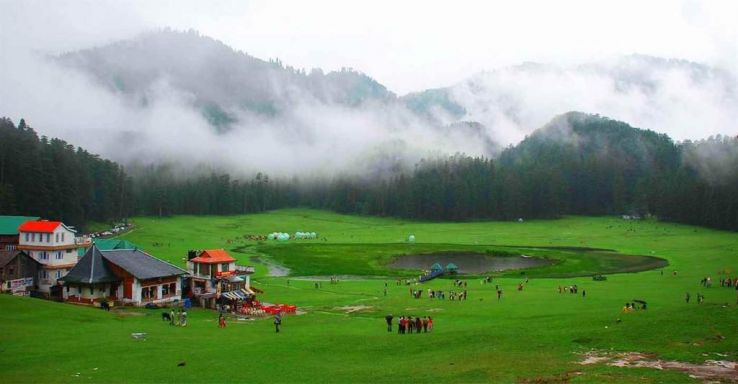
Paragliding Capital of India: Bir Billing is renowned as the paragliding capital of India, attracting paragliding enthusiasts from around the world.
Paragliding Takeoff Site: Billing is the takeoff site for paragliding, situated at an elevation of around 2,400 meters above sea level, offering panoramic views of the Himalayan ranges.
Paragliding Landing Site: Bir serves as the landing site for paragliding, located at a lower altitude of around 1,300 meters above sea level.
Bir Monastery: A prominent Tibetan Buddhist monastery, Bir Monastery is known for its peaceful ambiance, colorful murals, and traditional Tibetan architecture.
Deer Park Institute: A center for study and practice of classical Indian wisdom traditions, offering courses, workshops, and retreats on spirituality, philosophy, and meditation.
Chokling Monastery: Another Tibetan Buddhist monastery in Bir, Chokling Monastery is dedicated to the renowned Tibetan Buddhist master, Tulku Urgyen Rinpoche.
Bir Tea Factory: Visit the Bir Tea Factory to learn about the tea-making process and sample a variety of organic teas produced in the region.
Bir Road Market: Explore the local market in Bir, offering handicrafts, souvenirs, Tibetan artifacts, and traditional Himachali goods.
Bir Trekking Trails: Embark on scenic trekking trails around Bir, offering opportunities to explore the picturesque landscapes, lush forests, and quaint villages.
Baijnath Temple: Located near Bir, Baijnath Temple is an ancient Hindu temple dedicated to Lord Shiva, known for its architectural beauty and religious significance.
Best time to visit Bir Billing is during the months of March to May and September to November when the weather is pleasant and ideal for paragliding, trekking, and exploring the natural beauty of the region. Avoid visiting during the monsoon season June to August as heavy rainfall can disrupt outdoor activities and paragliding operations.
How to reach: To reach Bir Billing, you can fly into Kangra Airport Gaggal Airport in Dharamshala, which is the nearest airport, and then travel by road to Bir, approximately a 2 to 3-hour drive away. Alternatively, you can also take a train to Pathankot Railway Station and then proceed by road to Bir, or hire a taxi directly from major cities like Delhi or Chandigarh.
15. Coonoor
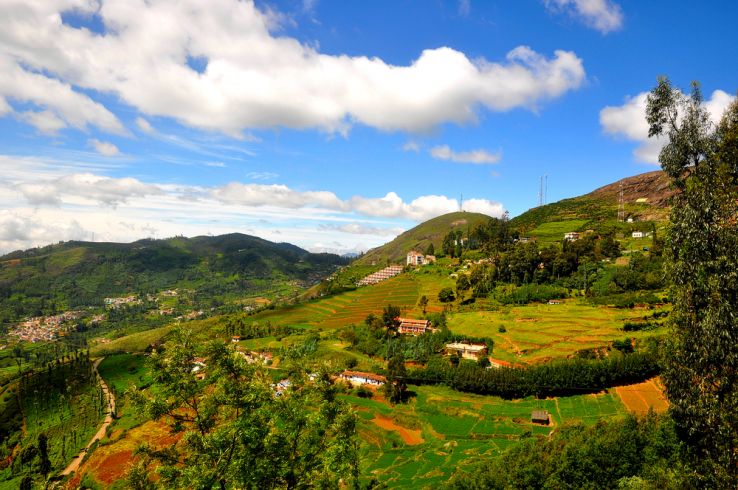
Sim's Park: A well-maintained botanical garden known for its diverse collection of plant species, manicured lawns, and scenic landscapes.
Dolphin's Nose Viewpoint: Offering breathtaking views of the surrounding valleys, hills, and tea estates, with the shape of the rock resembling a dolphin's nose.
Lamb's Rock: Another popular viewpoint providing panoramic views of the lush green Nilgiri hills and the Coimbatore plains.
Highfield Tea Factory: Visit this tea factory to learn about the tea-making process, from plucking to processing, and sample a variety of freshly brewed teas.
Catherine Falls: A picturesque waterfall nestled amidst dense forests, accessible via a short trek through the scenic Nilgiri hills.
Law's Falls: A serene waterfall cascading down the rocks, surrounded by lush greenery and offering a tranquil retreat from the city.
Droog Fort: An ancient hilltop fort offering panoramic views of the Nilgiri hills and the surrounding countryside, with remnants of the fort's architecture still intact.
Wellington Gymkhana Club Golf Course: Enjoy a round of golf amidst the picturesque surroundings of the Nilgiri hills at this historic golf course.
Hidden Valley: A hidden gem in Coonoor, offering scenic walking trails, lush greenery, and opportunities for birdwatching amidst pristine natural surroundings.
Pomological Station: An agricultural research station known for its fruit orchards and experimental gardens, where visitors can learn about horticulture and sample fresh fruits.
Best time to visit: Coonoor is during the months of October to March, when the weather is pleasant and cool, making it ideal for exploring the lush greenery, tea estates, and scenic viewpoints. Avoid visiting during the monsoon season June to September as heavy rainfall can lead to landslides and hinder outdoor activities.
How to reach: To reach Coonoor, you can fly into Coimbatore International Airport, which is the nearest airport located about 70 kilometers away. From there, you can hire a taxi or take a bus to Coonoor. Additionally, Coonoor is well-connected by train, with Coonoor Railway Station being a stop on the Nilgiri Mountain Railway line.
16. Ratnagiri
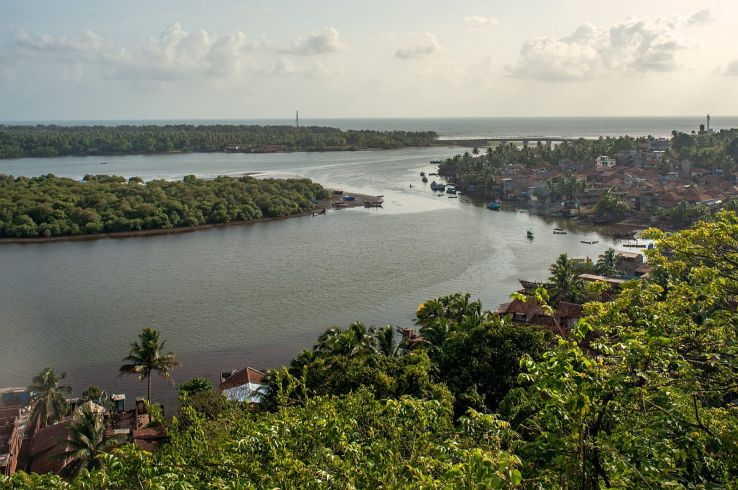
If you are looking for an out of the box experience then plan your trip to Ratnagiri, where you can witness the newly hatched Olive
Ratnadurg Fort Bhagwati Fort: A historic fort overlooking the Arabian Sea, offering panoramic views of the coastline and housing ancient temples, bastions, and cannon emplacements.
Ganapatipule Beach: A pristine beach known for its golden sands, clear waters, and the famous Ganpati Temple located on the shore.
Thibaw Palace: A former residence of the exiled Burmese king Thibaw Min, now converted into a museum showcasing artifacts, royal memorabilia, and historical exhibits.
Ratnagiri Marine Fish Museum: An aquarium and marine museum showcasing a variety of marine life, including colorful fish, coral reefs, and sea creatures native to the Konkan coast.
Ratnagiri Lighthouse: A historic lighthouse built during the British colonial era, offering panoramic views of the Arabian Sea and surrounding landscapes.
Pawas: A serene village known for its tranquil beaches, ancient temples, and the ashram of Swami Swaroopanand, a revered spiritual leader.
Thiba Point: Named after King Thibaw of Burma, Thiba Point offers scenic views of the sea and is a popular spot for picnics and leisurely walks.
Jaigad Fort: A coastal fort built by the Maratha king Shivaji, situated at the mouth of the Jaigad Creek and offering panoramic views of the Arabian Sea.
Anjarle Beach: A secluded beach known for its pristine shoreline, gentle waves, and the historic Kadyavarcha Ganpati Temple located nearby.
Ratnagiri Fruit Research Center: A research center dedicated to the cultivation and development of tropical fruits, offering guided tours and insights into horticulture and fruit breeding.
Best time to visit: Ratnagiri is during the winter months, from November to February, when the weather is pleasant and cool, ideal for exploring the beaches, forts, and other attractions. Avoid visiting during the monsoon season June to September as heavy rainfall can lead to landslides and hinder travel plans.
How to reach: To reach Ratnagiri, you can fly into Ratnagiri Airport, which is the nearest airport located about 8 kilometers away, with limited flight options. Alternatively, you can travel by train to Ratnagiri Railway Station, which is well-connected to major cities like Mumbai and Pune. Additionally, Ratnagiri is accessible by road via national highways, with regular bus services available from nearby cities and towns.
17. Ranthambore
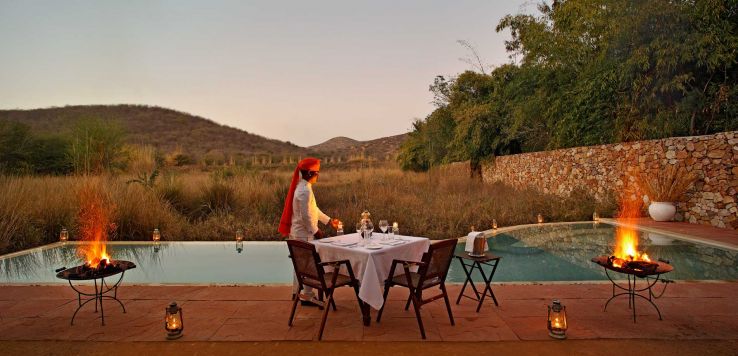
Ranthambore is wildlife lovers paradise and nothing like to spot the animals in the balmy afternoons of February month.
Ranthambore National Park: A renowned wildlife sanctuary and tiger reserve, known for its thriving population of Bengal tigers, as well as other wildlife species like leopards, sloth bears, and various bird species.
Ranthambore Fort: A UNESCO World Heritage Site, Ranthambore Fort is an ancient hilltop fortress dating back to the 10th century, offering panoramic views of the surrounding landscapes and housing ancient temples, palaces, and reservoirs.
Tiger Safaris: Embark on thrilling jeep safaris or canter safaris through Ranthambore National Park to spot Bengal tigers and other wildlife species in their natural habitat.
Padam Talao: The largest lake in Ranthambore National Park, Padam Talao is a scenic water body known for its picturesque landscapes and as a prime location for tiger sightings.
Jogi Mahal: A historic hunting lodge located near Padam Talao, Jogi Mahal is now a forest rest house and serves as a popular spot for picnics and birdwatching.
Rajbagh Ruins: Ancient ruins located within Ranthambore National Park, believed to be the remnants of the erstwhile royal hunting lodge, with architectural remnants and serene surroundings.
Kachida Valley: A picturesque valley known for its rugged landscapes, dense vegetation, and as a habitat for leopards, sloth bears, and various bird species.
Malik Talao: Another scenic lake within Ranthambore National Park, Malik Talao is a popular spot for birdwatching, with numerous migratory bird species visiting during the winter months.
Rajiv Gandhi Regional Museum of Natural History: Located near the entrance of Ranthambore National Park, this museum showcases the flora, fauna, and ecology of the region through interactive exhibits and displays.
Surwal Lake: A serene lake located on the outskirts of Ranthambore National Park, Surwal Lake is a popular spot for birdwatching, with numerous bird species found in the surrounding wetlands.
Best time to visit: Ranthambore is from October to March, during the winter and early spring months, when the weather is pleasant and ideal for wildlife safaris, with higher chances of spotting tigers and other animals. Avoid visiting during the summer months April to June when temperatures can soar, making wildlife sightings more challenging.
How to reach: To reach Ranthambore, you can fly into Jaipur Airport, which is the nearest airport located about 180 kilometers away, and then travel by road to Ranthambore. Alternatively, you can take a train to Sawai Madhopur Railway Station, which is the nearest railway station, and then proceed by road to Ranthambore, approximately a 30-minute drive away.
18. Khajuraho
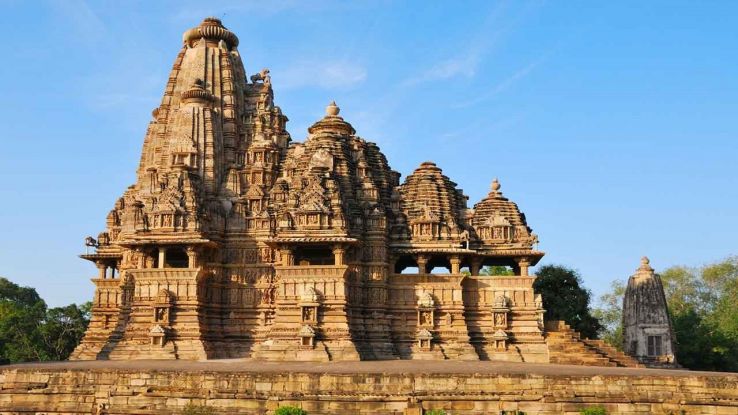
Khajuraho in Madhya Pradesh is known for its intricately done temples adorned with sensuous and erotic carvings, which depicts the love and passion in the most erotic and aesthetic ways.
Khajuraho Group of Monuments: A UNESCO World Heritage Site, the Khajuraho Group of Monuments comprises a stunning collection of Hindu and Jain temples, known for their intricate carvings, exquisite architecture, and intricate sculptures depicting various aspects of life.
Lakshmana Temple: One of the largest and most well-preserved temples in Khajuraho, dedicated to Lord Vishnu, featuring intricate carvings, sculptures, and ornate architecture.
Kandariya Mahadeva Temple: The largest and most ornate temple in Khajuraho, dedicated to Lord Shiva, renowned for its intricate carvings, sculptures, and erotic depictions.
Chaturbhuj Temple: A unique temple dedicated to Lord Vishnu, known for its four-armed deity and its distinct architectural style.
Jain Temples: Explore the Jain temples at Khajuraho, known for their simplicity, elegance, and fine craftsmanship, with notable examples being the Parsvanath Temple, Adinath Temple, and Shantinath Temple.
Archaeological Museum: Visit the Archaeological Museum in Khajuraho to view a collection of artifacts, sculptures, and relics unearthed from the surrounding temples and archaeological sites.
Raneh Falls: Located about 20 kilometers from Khajuraho, Raneh Falls is a spectacular waterfall nestled amidst pristine natural surroundings, offering breathtaking views and opportunities for photography and picnics.
Panna National Park: Explore the wilderness of Panna National Park, located near Khajuraho, known for its diverse flora and fauna, including tigers, leopards, deer, and migratory birds.
Beni Sagar Dam: A scenic reservoir located near Khajuraho, offering serene surroundings, boating facilities, and opportunities for birdwatching and nature walks.
Ajaigarh Fort: Visit the historic Ajaigarh Fort, located near Khajuraho, known for its ancient architecture, scenic views, and historical significance.
best time to visit: Khajuraho is during the winter months, from October to March, when the weather is pleasant and comfortable for exploring the temples and other attractions. Avoid visiting during the summer months April to June when temperatures can soar, making sightseeing uncomfortable.
How to reach: reach Khajuraho, you can fly into Khajuraho Airport, which is the nearest airport, offering domestic flights from major cities in India. Alternatively, you can take a train to Khajuraho Railway Station, which is well-connected to major cities like Delhi, Agra, and Varanasi.
19. Kodaikanal
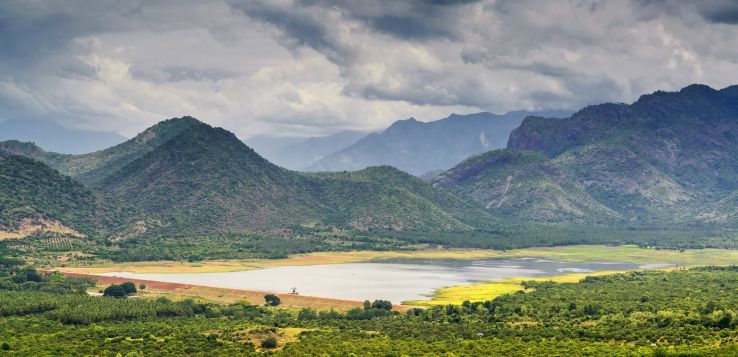
Kodaikanal known as the princess of Hill stations is the best places to visit in February in India.
Kodaikanal Lake: A serene man-made lake surrounded by lush greenery, offering boating facilities, cycling paths, and scenic views of the surrounding hills.
Bryant Park: A botanical garden located near Kodaikanal Lake, known for its diverse collection of flowers, plants, and trees, as well as colorful flower shows held during the summer months.
Coaker's Walk: A picturesque walking trail offering panoramic views of the surrounding valleys, hills, and mist-covered landscapes.
Pillar Rocks: A popular tourist attraction, Pillar Rocks comprises three massive rock formations standing tall amidst dense forests, offering breathtaking views of the surrounding landscapes.
Bear Shola Falls: A tranquil waterfall located amidst dense forests, accessible via a short trek through scenic trails, and ideal for picnics and nature walks.
Dolphin's Nose: A scenic viewpoint offering panoramic views of the surrounding hills, valleys, and the distant plains, with the rock formation resembling the shape of a dolphin's nose.
Silver Cascade Falls: A majestic waterfall cascading down the rocks amidst lush greenery, offering a refreshing retreat and opportunities for photography.
Green Valley Viewpoint: Also known as Suicide Point, this viewpoint offers stunning views of the verdant valleys, mist-covered hills, and the Vaigai Dam in the distance.
Berijam Lake: A serene reservoir located amidst dense forests and rolling hills, offering opportunities for boating, fishing, and birdwatching.
Kurinji Andavar Temple: A popular temple dedicated to Lord Murugan, known for its vibrant architecture and the Kurinji flower, which blooms once in 12 years and covers the surrounding hills in blue.
Best time to visit: Kodaikanal is during the months of April to June and September to October, when the weather is pleasant and conducive to outdoor activities. Avoid visiting during the monsoon season July to August when heavy rainfall can lead to landslides and disrupt travel plans
How to reach: Kodaikanal, you can fly into Madurai Airport, which is the nearest airport located about 120 kilometers away, and then travel by road to Kodaikanal. Alternatively, you can take a train to Kodai Road Railway Station, which is the nearest railway station, and then proceed by road to Kodaikanal, approximately a 2 to 3-hour drive away
20. Ludhiana
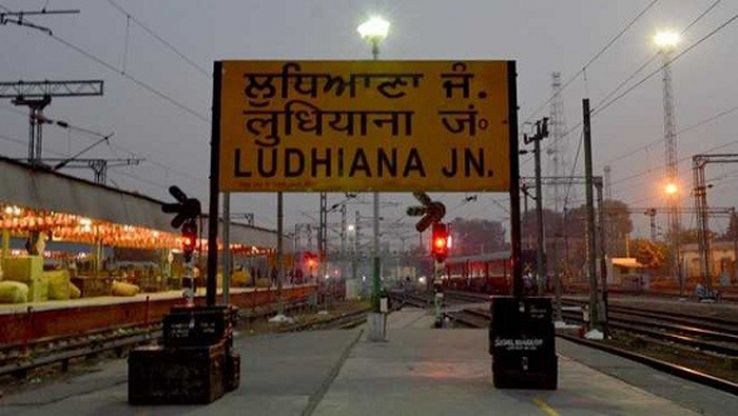
Punjab Agricultural University Museum: A museum showcasing the history and development of agriculture in Punjab, with exhibits on farming techniques, agricultural machinery, and crop varieties.
Lodhi Fort: A historic fort built by Sikander Lodhi in the 15th century, offering panoramic views of Ludhiana city and housing ancient ruins, mosques, and gates.
Guru Nanak Stadium: A multi-purpose stadium known for hosting sports events, cultural programs, and concerts, with facilities for various sports like cricket, football, and athletics.
Phillaur Fort: A historic fort built by Maharaja Ranjit Singh, now converted into a police training academy, with a museum showcasing artifacts related to Punjab's history and culture.
Punjab Rural Heritage Museum: A museum dedicated to showcasing the rural life and culture of Punjab, with exhibits on traditional Punjabi homes, handicrafts, and agricultural implements.
Maharaja Ranjit Singh War Museum: A museum commemorating the military history of Punjab and the contributions of Maharaja Ranjit Singh, featuring weapons, uniforms, and war memorabilia.
Nehru Rose Garden: A beautiful garden spread over 30 acres, featuring thousands of rose varieties, fountains, and landscaped lawns, ideal for picnics and leisurely walks.
Hardy's World Amusement Park: A popular amusement park offering a variety of rides, water slides, and entertainment options for visitors of all ages.
Guru Nanak Dev Bhawan: A cultural center and auditorium hosting cultural events, exhibitions, and performances, with facilities for conferences, seminars, and workshops.
Punjab Agricultural University: Explore the sprawling campus of Punjab Agricultural University, known for its research and education in agriculture, with beautiful gardens, research fields, and agricultural labs.
Best time to visit: Ludhiana is during the winter months, from October to March, when the weather is cool and pleasant, making it ideal for exploring the city's attractions and outdoor activities. Avoid visiting during the summer months April to June when temperatures can soar, making outdoor activities uncomfortable.
How to reach: Ludhiana, you can fly into Sri Guru Ram Dass Jee International Airport in Amritsar, which is the nearest airport located about 130 kilometers away, and then travel by road or train to Ludhiana. Alternatively, you can take a train directly to Ludhiana Railway Station, which is well-connected to major cities like Delhi, Mumbai, and Kolkata.
21. Delhi
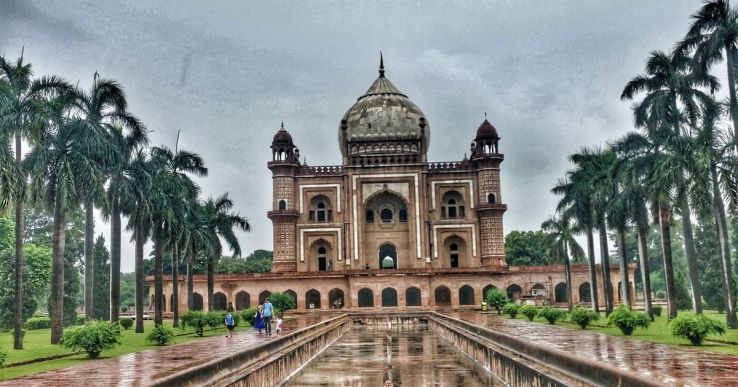
Delhi winters are famous all over, and February is officially the last month of the winter season in Delhi.
Red Fort: A UNESCO World Heritage Site, Red Fort is an iconic Mughal-era fortress known for its stunning architecture, including intricate marble inlays and the iconic Diwan-i-Khas.
Qutub Minar: Another UNESCO World Heritage Site, Qutub Minar is the tallest brick minaret in the world, dating back to the 12th century and showcasing exquisite Islamic architecture.
India Gate: A prominent war memorial located in the heart of Delhi, India Gate commemorates the soldiers who died in World War I and the Third Anglo-Afghan War.
Lotus Temple: A Bahá'í House of Worship known for its distinctive lotus-shaped architecture, offering a serene atmosphere for meditation and prayer.
Humayun's Tomb: Yet another UNESCO World Heritage Site, Humayun's Tomb is a magnificent Mughal-era mausoleum known for its symmetrical gardens, intricate carvings, and Persian-influenced architecture.
Jama Masjid: One of the largest mosques in India, Jama Masjid is a magnificent example of Mughal architecture, featuring red sandstone domes, marble minarets, and a vast courtyard.
Akshardham Temple: A sprawling Hindu temple complex known for its stunning architecture, intricate carvings, and cultural exhibitions showcasing Indian art, history, and spirituality.
Chandni Chowk: One of the oldest and busiest markets in Delhi, Chandni Chowk is a bustling hub of activity known for its narrow lanes, vibrant bazaars, and delicious street food.
National Museum: The National Museum of India is the largest museum in the country, housing a vast collection of artifacts, sculptures, and artworks spanning thousands of years of Indian history and culture.
Raj Ghat: A simple yet powerful memorial marking the spot where Mahatma Gandhi was cremated, surrounded by beautiful gardens and serene surroundings.
Best time to visit: Delhi is during the winter months, from October to March, when the weather is pleasant with cool temperatures, making it ideal for exploring the city's attractions and outdoor activities. Avoid visiting during the summer months April to June when temperatures can soar, making sightseeing uncomfortable.
How to reach: Delhi, you can fly into Indira Gandhi International Airport, which is one of the busiest airports in India, serving domestic and international flights. Additionally, Delhi is well-connected by train, with several major railway stations like New Delhi Railway Station, Old Delhi Railway Station, and Hazrat Nizamuddin Railway Station.
22. Ooty
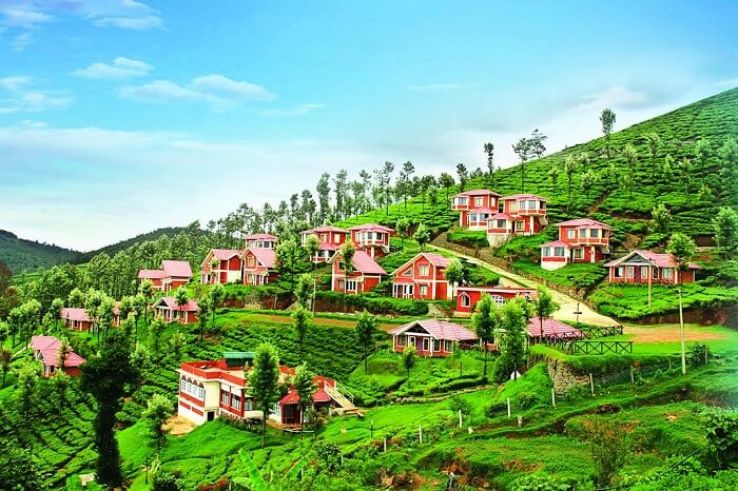
Ooty known as the queen of Hill stations is the best places to visit in February if someone is wishing to enjoy the winters in the true sense, then this is the place to be.
Ooty Lake: A scenic artificial lake surrounded by lush greenery, offering boating facilities, lakeside promenades, and stunning views of the surrounding hills.
Botanical Gardens: The Government Botanical Garden in Ooty is a sprawling garden spread over 55 acres, featuring thousands of plant species, exotic flowers, and towering trees, including a fossilized tree trunk dating back millions of years.
Doddabetta Peak: The highest peak in the Nilgiri Hills, Doddabetta Peak offers panoramic views of the surrounding valleys, tea estates, and distant hills, accessible via a short trek or drive.
Rose Garden: Also known as the Centenary Rose Park, the Rose Garden in Ooty is home to thousands of rose varieties, including rare and exotic species, with colorful blooms and well-manicured lawns.
Ooty Toy Train: Ride the UNESCO World Heritage-listed Nilgiri Mountain Railway, a charming narrow-gauge steam train that travels from Ooty to Mettupalayam, offering scenic views of the Nilgiri hills and tea estates.
Tea Estates: Explore the lush tea estates surrounding Ooty, such as the scenic Doddabetta Tea Estate and the picturesque Glenmorgan Tea Estate, where you can learn about tea cultivation and sample freshly brewed tea.
Emerald Lake: A serene lake nestled amidst tea plantations and rolling hills, offering a tranquil retreat and opportunities for picnics, boating, and birdwatching.
Avalanche Lake: Located about 25 kilometers from Ooty, Avalanche Lake is a pristine water body surrounded by dense forests and snow-capped mountains, accessible via a scenic trek or drive.
Tribal Museum: Visit the Tribal Research Center and Museum in Ooty to learn about the indigenous tribes of the Nilgiri hills, their culture, traditions, and artifacts.
Ooty Rose Show: Attend the annual Ooty Rose Show held in the month of May, showcasing thousands of rose varieties from across the world, with competitions, exhibitions, and cultural performances.
Best time to visit: Ooty is during the months of April to June and September to November when the weather is pleasant and the flowers are in full bloom, making it ideal for sightseeing, outdoor activities, and enjoying the scenic beauty of the region. Avoid visiting during the monsoon season July to September when heavy rainfall can lead to landslides and disrupt travel plans.
How to reach: Ooty, you can fly into Coimbatore International Airport, which is the nearest airport located about 88 kilometers away, and then travel by road or take a taxi to Ooty. Alternatively, you can take a train to Mettupalayam Railway Station, which is well-connected to major cities like Chennai and Coimbatore, and then board the Nilgiri Mountain Railway, a charming toy train that takes you on a scenic journey up to Ooty.
23. Daman and Diu
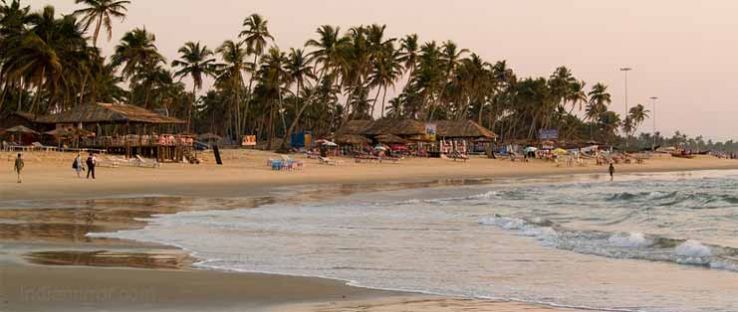
Daman and Diu the union territory of India was under the control of Portuguese for over 450 years, thus the architecture and buildings in Daman and Diu still have a reflection of those days.
Diu Fort: A historic Portuguese fort built in the 16th century, offering panoramic views of the Arabian Sea and housing ancient churches, cannons, and lighthouses.
Naida Caves: A network of natural limestone caves located near Diu Fort, featuring intricate rock formations, underground chambers, and tunnels.
St. Paul's Church: A 17th-century colonial-era church located within Diu Fort, known for its Baroque architecture, wooden altars, and beautiful stained glass windows.
Diu Beaches: Explore the pristine beaches of Diu, such as Nagoa Beach, Ghogla Beach, and Jalandhar Beach, known for their golden sands, clear waters, and water sports activities.
Gangeshwar Temple: A historic Hindu temple dedicated to Lord Shiva, known for its five lingams located amidst the rocks on the seashore, believed to have been installed by the Pandavas during their exile.
Diu Museum: Visit the Diu Museum located within the Diu Fort complex, showcasing artifacts, sculptures, and exhibits related to the history, culture, and heritage of Daman and Diu.
Fortim-do-Mar: A scenic promenade located near the Diu Fort, offering panoramic views of the Arabian Sea and the coastline, with walking paths, gardens, and seaside cafes.
Nagoa Fort: An ancient Portuguese fort located near Nagoa Beach, offering picturesque views of the surrounding landscapes and serving as a popular picnic spot.
Sunset Point: Enjoy stunning views of the sunset over the Arabian Sea from Sunset Point, located near Chakratirth Beach, offering a tranquil setting for relaxation and photography.
Shell Museum: Explore the Shell Museum in Diu, showcasing a vast collection of seashells, corals, and marine specimens, with exhibits on marine life, biodiversity, and conservation efforts.
Best time to visit: Daman and Diu is during the winter months, from November to February, when the weather is pleasant and the temperatures are mild, making it ideal for exploring the beaches, forts, and other attractions. Avoid visiting during the monsoon season June to September when heavy rainfall can disrupt travel plans and water sports activities.
How to reach: Daman and Diu, you can fly into Mumbai Airport, which is the nearest major airport, and then travel by road or take a train to Vapi Railway Station in Gujarat. From Vapi, Daman is about a 15-minute drive away. Alternatively, you can also travel by road from major cities like Ahmedabad, Surat, and Vadodara, with well-maintained highways connecting to Daman and Diu.
24. Mumbai
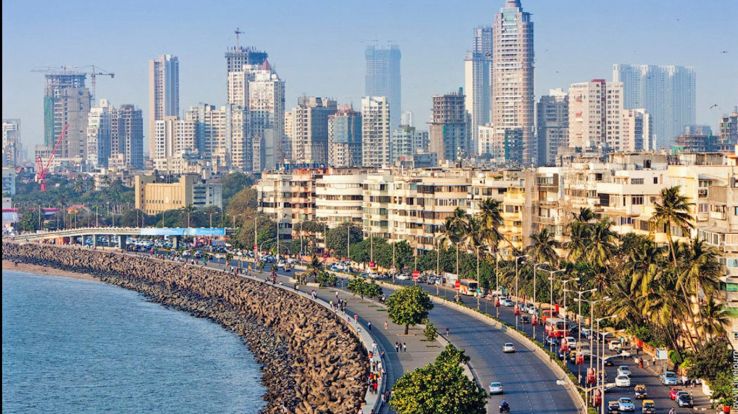
Mumbai in the month of February offers many fests and amazing nightlife to attend. The pleasant weather and cold winds in the evening make Mumbai all the more happening in the month of February.
Gateway of India: An iconic landmark and historic monument located on the waterfront in South Mumbai, offering stunning views of the Arabian Sea and serving as a popular gathering spot for locals and tourists.
Marine Drive: A picturesque promenade along the Arabian Sea, also known as the Queen's Necklace due to its curved shape and glittering lights resembling a necklace at night.
Elephanta Caves: A UNESCO World Heritage Site, located on Elephanta Island in Mumbai Harbor, known for its ancient rock-cut temples, intricate sculptures, and Hindu cave art dating back to the 5th to 8th centuries.
Chhatrapati Shivaji Maharaj Vastu Sangrahalaya formerly Prince of Wales Museum: A renowned museum in Mumbai, showcasing a vast collection of artifacts, sculptures, paintings, and decorative arts, spanning Indian and international history and culture.
Juhu Beach: A popular beach destination in Mumbai, known for its golden sands, vibrant atmosphere, and a variety of street food stalls offering Mumbai's famous snacks and delicacies.
Bollywood Tour: Explore the vibrant world of Bollywood with a guided tour of Film City or a visit to one of Mumbai's iconic film studios, offering behind-the-scenes glimpses of movie sets, costumes, and film production.
Haji Ali Dargah: A revered Islamic shrine and mausoleum located on an islet off the coast of Worli, accessible via a causeway during low tide, attracting devotees of all faiths with its stunning architecture and spiritual ambiance.
Sanjay Gandhi National Park: A sprawling national park located in the northern suburbs of Mumbai, offering lush greenery, dense forests, and a variety of flora and fauna, as well as attractions like Kanheri Caves and Tiger Safari.
Crawford Market: A bustling market in South Mumbai, known for its vibrant atmosphere, diverse range of products, and architectural beauty, with stalls selling fruits, vegetables, spices, and household goods.
Siddhivinayak Temple: A renowned Hindu temple dedicated to Lord Ganesha, located in Prabhadevi area of Mumbai, attracting thousands of devotees daily with its grand architecture and spiritual significance.
Best time to visit: Mumbai is during the winter months, from November to February, when the weather is cooler and more pleasant, making it ideal for sightseeing and outdoor activities. Avoid visiting during the monsoon season June to September when heavy rainfall can lead to flooding and disrupt travel plans.
How to reach: Mumbai, you can fly into Chhatrapati Shivaji Maharaj International Airport, one of the busiest airports in India, with domestic and international flights. Additionally, Mumbai is well-connected by train, with several major railway stations like Mumbai Central, Chhatrapati Shivaji Maharaj Terminus, and Bandra Terminus serving as key transportation hubs for travelers arriving by train from various parts of the country.
25. Visakhapatnam
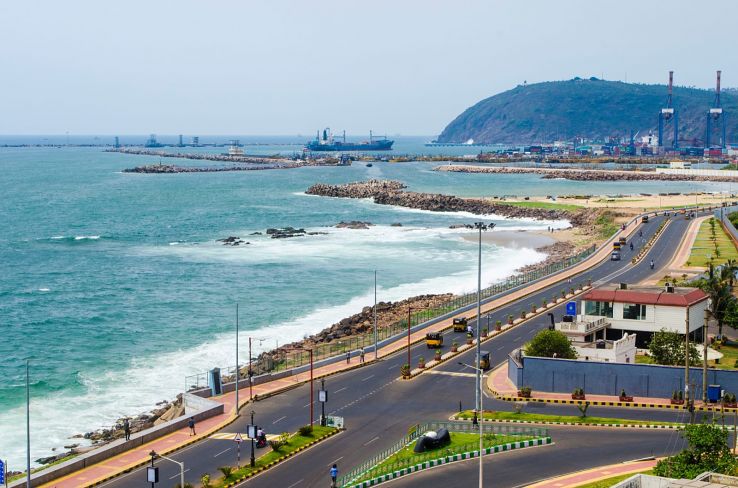
Visakhapatnam the city of destiny is the best places to explore in February, the pleasant weather and plenty of beaches, makes it no less than Vegas of India. As it is very difficult to find locations in India where you will get cold-weather and beaches together.
Ramakrishna Beach RK Beach: A popular beach destination in Visakhapatnam, known for its golden sands, serene waters, and scenic promenade lined with statues, parks, and eateries.
Kailasagiri: A picturesque hilltop park offering panoramic views of Visakhapatnam city and the Bay of Bengal, with lush greenery, flower gardens, ropeway rides, and a giant statue of Lord Shiva and Goddess Parvati.
Borra Caves: A fascinating natural wonder located in the Araku Valley, about 90 kilometers from Visakhapatnam, known for its stunning limestone formations, stalactites, and stalagmites.
INS Kurusura Submarine Museum: A unique museum housed within a decommissioned submarine, offering insights into naval history, submarine operations, and life aboard a submarine.
Kambalakonda Wildlife Sanctuary: A sprawling sanctuary located on the outskirts of Visakhapatnam, offering opportunities for wildlife spotting, nature walks, trekking, and birdwatching amidst lush greenery and rolling hills.
Yarada Beach: A pristine and secluded beach located about 15 kilometers from Visakhapatnam city, known for its golden sands, clear waters, and tranquil atmosphere, ideal for relaxation and picnics.
Simhachalam Temple: A renowned Hindu temple dedicated to Lord Varaha Narasimha, located atop a hill about 16 kilometers from Visakhapatnam, known for its ancient architecture, intricate carvings, and religious significance.
Rushikonda Beach: A popular beach destination known for its clean sands, clear waters, and water sports activities like surfing, jet-skiing, and parasailing, attracting both tourists and locals alike.
Indira Gandhi Zoological Park: A well-maintained zoo located in Visakhapatnam, home to a variety of animal species, including big cats, elephants, primates, and birds, with spacious enclosures and natural habitats.
Dolphin's Nose: A scenic viewpoint located on a hilltop near Visakhapatnam city, offering breathtaking views of the coastline, Vizag cityscape, and the Bay of Bengal, accessible via a short trek.
Best time to visit: Visakhapatnam is during the winter months, from October to February, when the weather is pleasant and conducive to outdoor activities like beach visits, sightseeing, and exploring the city's attractions. Avoid visiting during the monsoon season July to September when heavy rainfall and cyclones are common, leading to waterlogging and disruptions in travel plans.
How to reach: Visakhapatnam, you can fly into Visakhapatnam Airport, which is well-connected with domestic and some international flights. Alternatively, you can take a train to Visakhapatnam Railway Station, a major railway junction that connects the city with various parts of India
26. Summary of 25 best places to visit in February in India
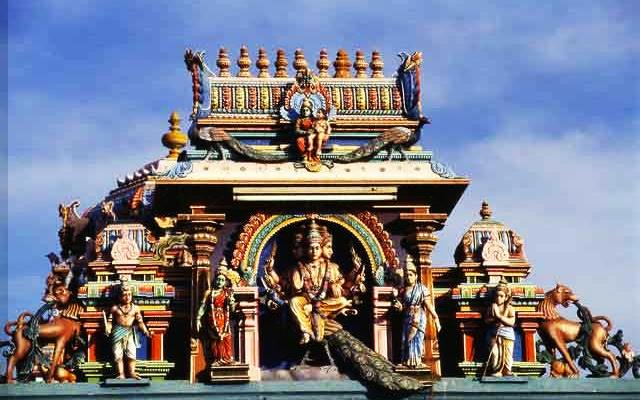
1. Gulmarg
2. Jaisalmer
3. Goa
4. Coorg
5. Andaman and Nicobar Islands
6. Sikkim
7. Prayagraj also called Allahabad
8.Agra
9. Puri, Orissa
10. Rann of Kutch
11. Bengaluru
12. Nashik
13.Thekkday
14. Bir Billing
15. Coonoor
16. Ratnagiri
17. Ranthambore
18. Khajuraho
19. Kodaikanal
20. Ludhiana
21. Delhi
22. Ooty
23. Daman and Diu
24. Mumbai
25. Visakhapatnam
Recommended For You
-
 Best Places to Stay During Kumbh 2025: From Tents to Luxury Hotels
Best Places to Stay During Kumbh 2025: From Tents to Luxury Hotels
-
 The Ultimate Guide to Maha Kumbh Mela 2025 at Prayagraj
The Ultimate Guide to Maha Kumbh Mela 2025 at Prayagraj
-
 Understanding the Importance of the Sangam: The Confluence of Faith
Understanding the Importance of the Sangam: The Confluence of Faith
-
 The History and Mythology of Kumbh Mela: A Journey Through Time
The History and Mythology of Kumbh Mela: A Journey Through Time
-
 Best Places to Eat in Goa: Indulge in a Culinary Delight
Best Places to Eat in Goa: Indulge in a Culinary Delight
-
 The Future of Drone Tourism: How Drones are Changing the Travel Industry
The Future of Drone Tourism: How Drones are Changing the Travel Industry
